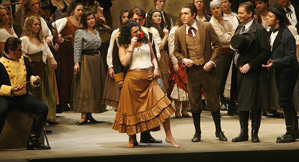SNAAP findings buck conventional wisdom: Arts graduates gauge success differently
A new report by the Strategic National Arts Alumni Project based at the Indiana University Center for Postsecondary Research offers important new insights into the value of an arts school education -- countering prevailing views about salary levels and job prospects as the most important indicators of alumni satisfaction and career success.
The SNAAP report, "Painting With Broader Strokes: Reassessing the Value of an Arts Degree," offers insights into the careers and perspectives of 13,851 arts graduates from 154 institutions surveyed in 2010 -- shedding new light on educational training and experiences, employment paths, involvement in the arts outside of work, and overall job satisfaction and income. Participating schools include research universities, independent colleges of art and design, conservatories, liberal arts colleges and arts high schools.
Among the report's key findings: a majority of arts graduates are happy with their intensive education in the arts and do not view salary levels as the dominant measures of their success.
Of those surveyed, 76 percent said they would attend the same educational institution again if they had to start over. In fact, even among unemployed arts alumni actively looking for work, 84 percent rate their arts school experiences as "good" or "excellent," and 68 percent would go back and do it over again.
"Typically, economists define the worth of a college degree by using earnings and employment rates," said Steven J. Tepper, SNAAP research director and associate director of the Curb Center for Art, Enterprise and Public Policy at Vanderbilt. "As a result, society often undervalues the educational experience itself and how it transforms and shapes lives. Arts graduates value what they learned in school and draw upon their training as they put together creative lives and careers."
SNAAP is the only research project of its kind that annually tracks the training, career trajectories and satisfaction of alumni on a regular basis at a national level. Since its start in 2008, SNAAP has surveyed more than 65,000 arts alumni from hundreds of schools, amassing data that provide an important window into the development of artists in the U.S. and Canada.
Other noteworthy findings from the new SNAAP report include:
- When it comes to current occupation, more arts graduates spend the majority of their time working in fields related to the arts (61 percent) than in other areas (39 percent).
- Sixty-two percent of those working primarily in a job outside the arts say their arts training is relevant to their current work.
- Arts graduates continue to support the arts at high rates even when they pursue careers in non-arts fields. Nearly a third -- 31 percent -- of alumni spending the majority of their work time in occupations outside the arts indicate they have volunteered at an arts organization within the past three years.
- Arts alumni still face significant financial obstacles to engaging in art professionally. Fifty-two percent of those who stopped working as professional artists did so because of better pay in other fields.
- Forty percent of respondents hold more than one job.
- Fourteen percent of SNAAP respondents founded their own (for-profit or nonprofit) companies. Media arts (including film/video as well as new/digital media) and design graduates are the most likely of all arts majors to start for-profit businesses.
- While 32 percent of alumni have found "using entrepreneurial skills" to be important within their working lives, only 20 percent describe their institutions as helping them "very much" or "quite a bit" to acquire or develop this capacity.
SNAAP is a collaboration between the Indiana University Center for Postsecondary Research and the Vanderbilt University Curb Center for Art, Enterprise and Public Policy. Participation in the annual survey is open to all degree-granting colleges and universities as well as arts high schools. Registration for next year's administration opens in March.
SNAAP was launched with support from the Surdna Foundation, the National Endowment for the Arts, Houston Endowment and other funders. The project is based at the Indiana University Center for Postsecondary Research at the School of Education in Bloomington. More information, including a copy of this special report, is available at snaap.indiana.edu.
 Rehearsal for a performance of the opera "Carmen" at Indiana University in 2006 (courtesy Indiana University).
Rehearsal for a performance of the opera "Carmen" at Indiana University in 2006 (courtesy Indiana University).